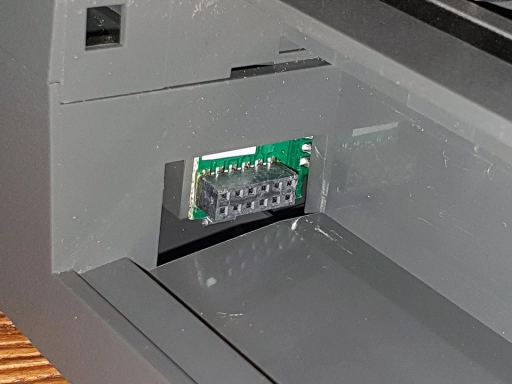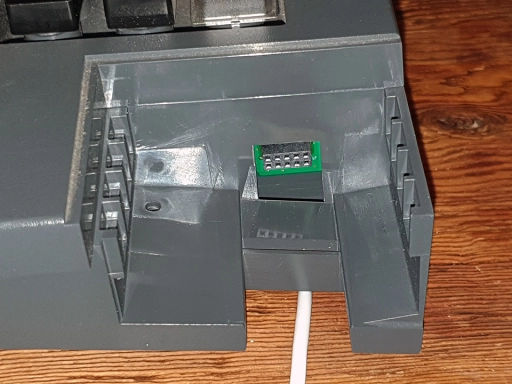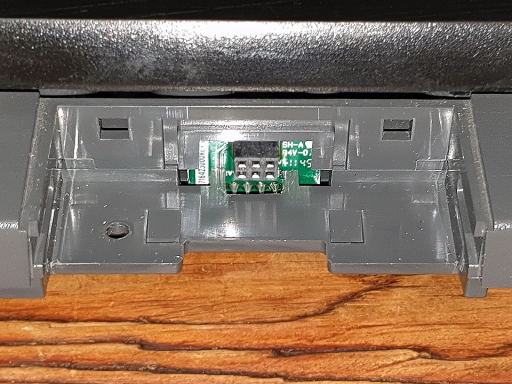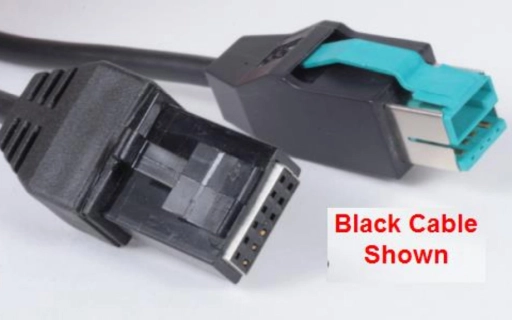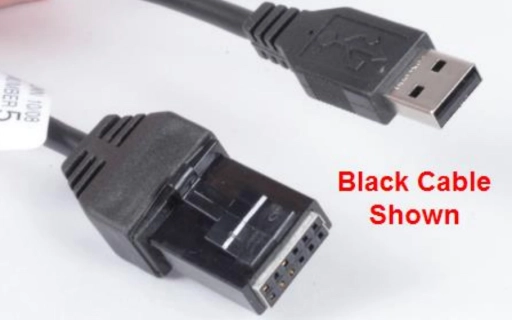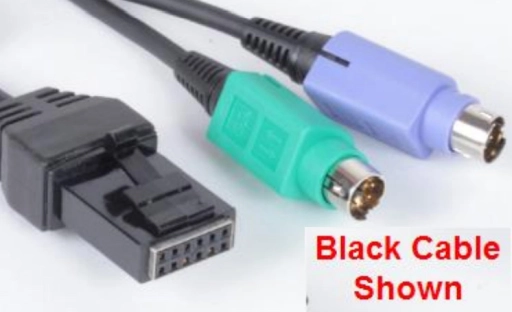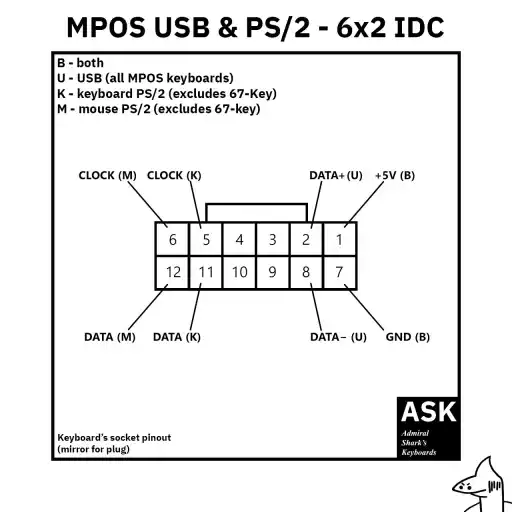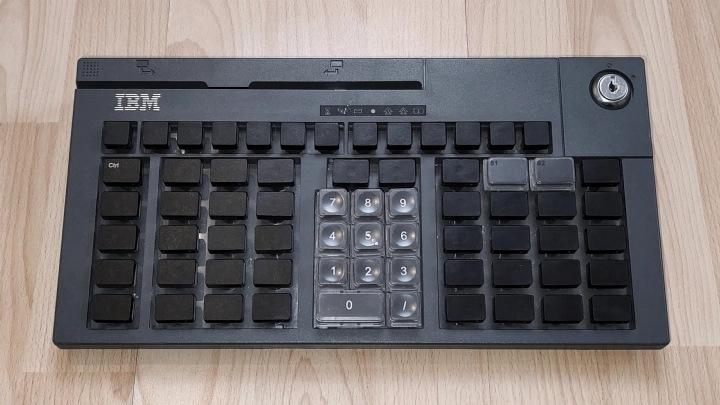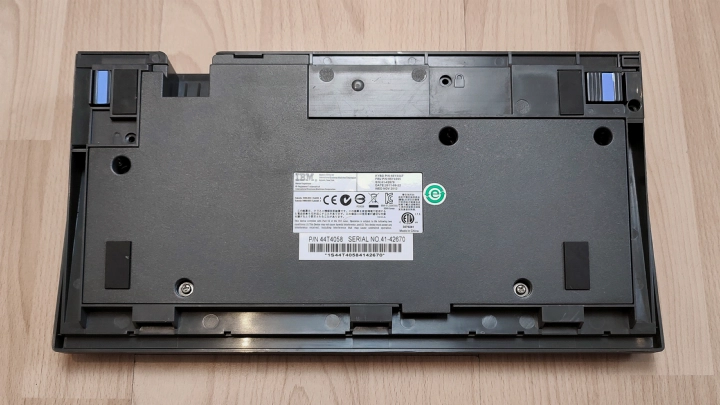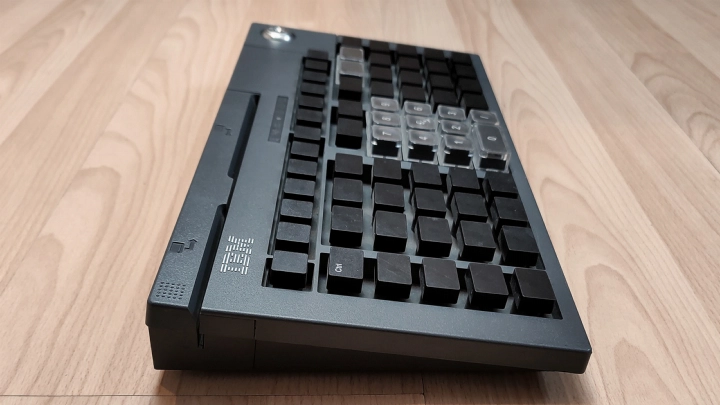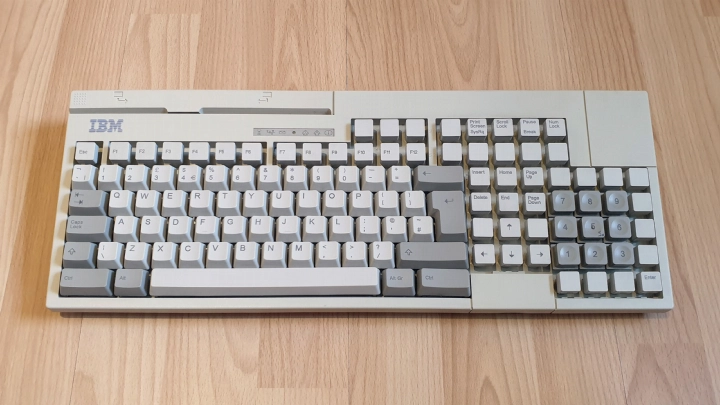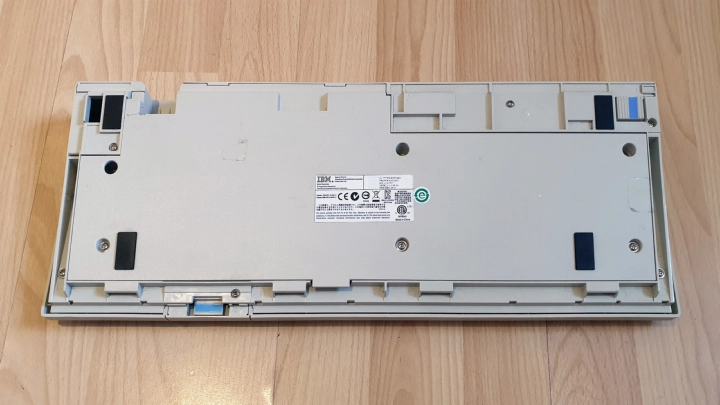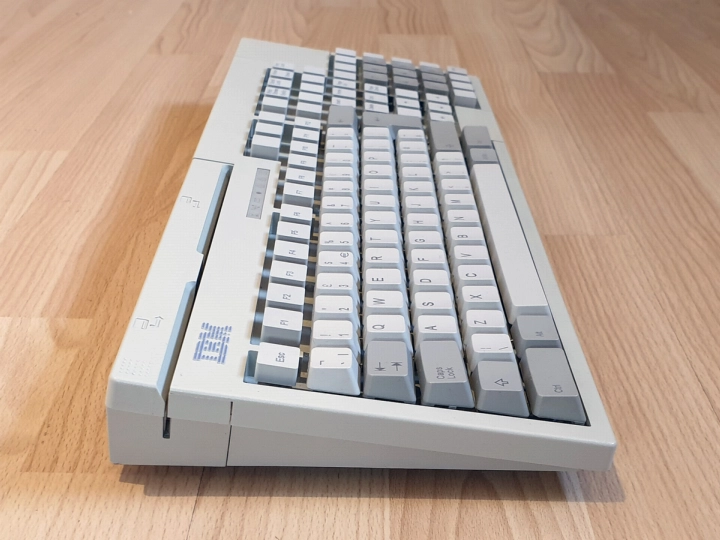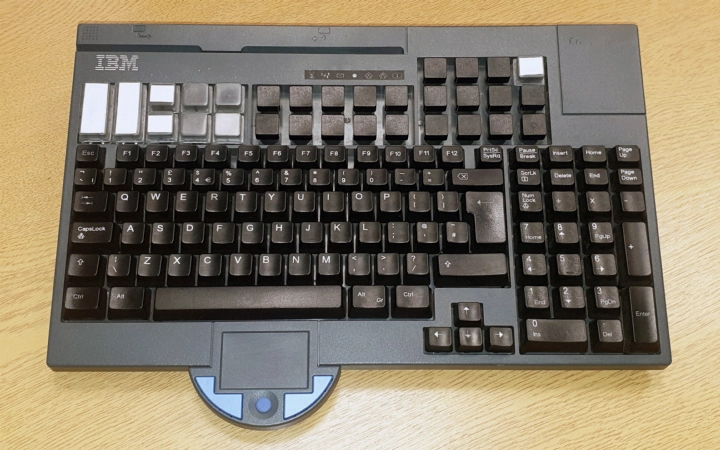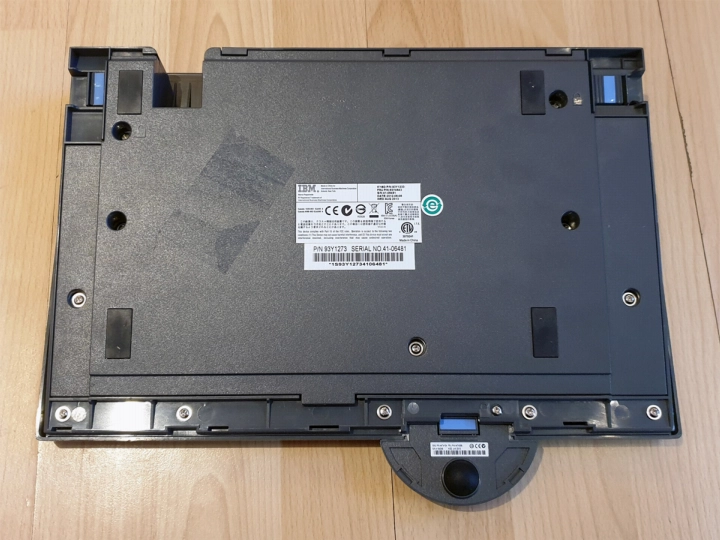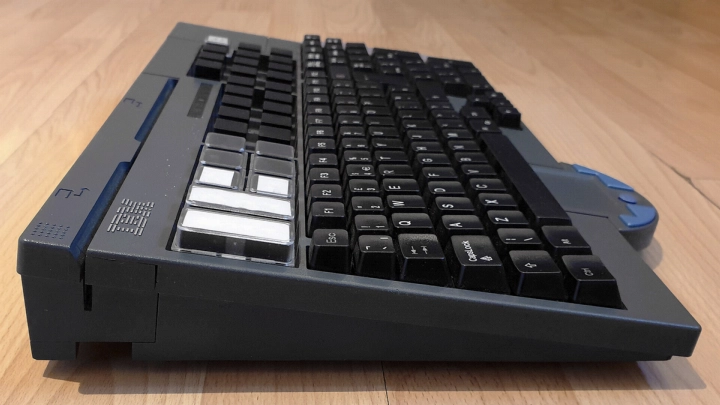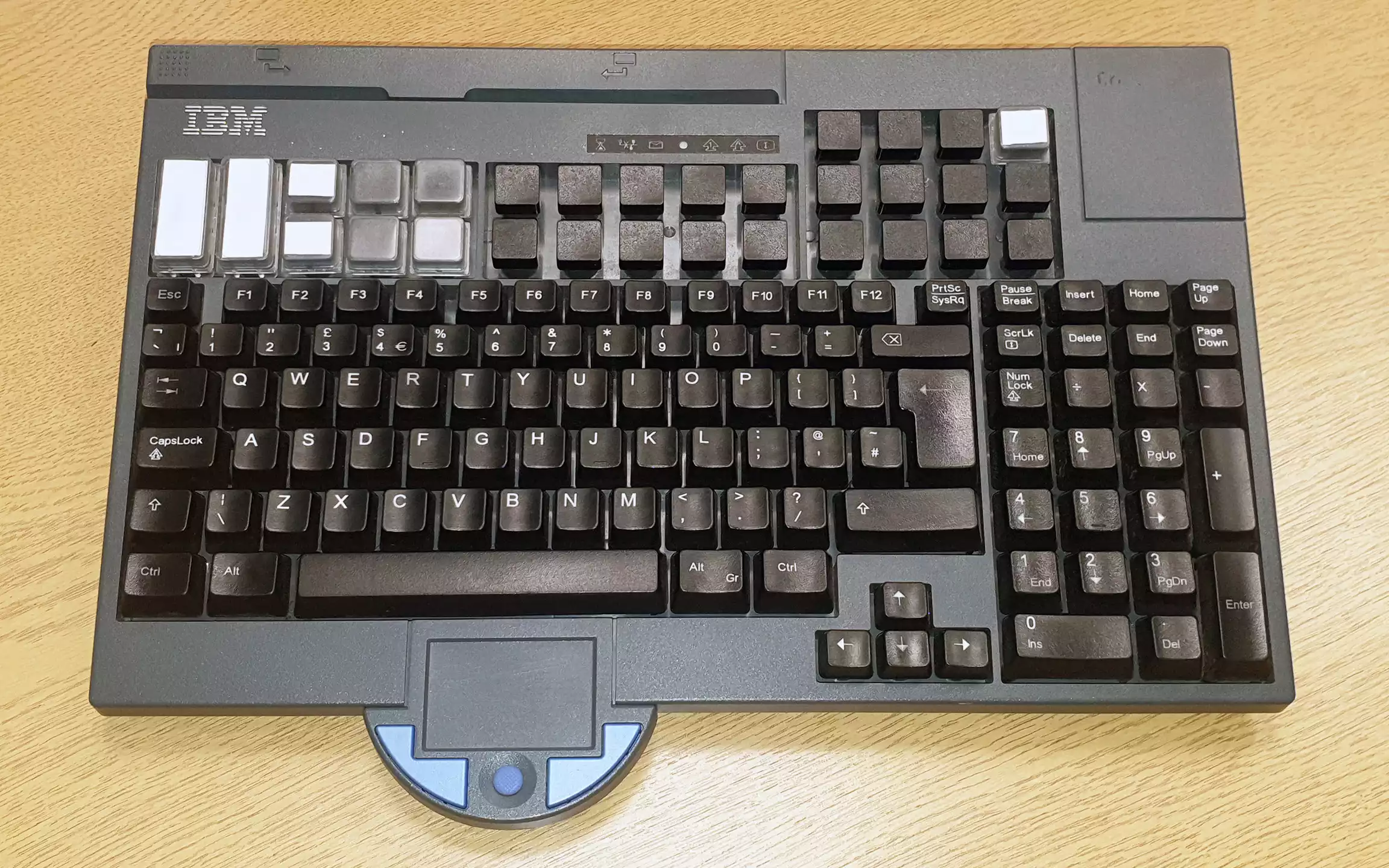Applies to IBM or Toshiba Modular 67-Key POS Keyboard, Modular 67-Key POS LCD Keyboard, Modular ANPOS Keyboard (ANPOS II) and Modular CANPOS Keyboard (CANPOS II)
- Updated
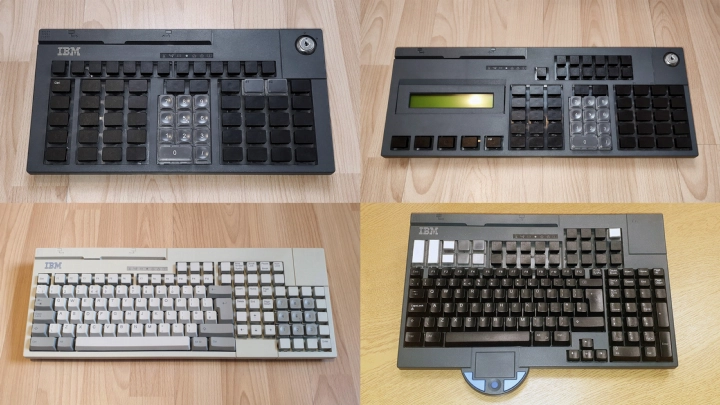
The IBM/Toshiba Modular series of POS (MPOS) input devices are a modern follow-up to the Retail series of POS (RPOS) input devices of the 1990s and 'pre-Modular' series of the 2000s. Originally introduced in 2008[1], the MPOS series fields analogues for almost all of IBM's previous offerings whilst retaining the same IBM buckling rubber sleeve keyswitch design and core layouts along with enhancing their features and in many cases adding more available buttons around said core design. MPOS input devices are provisionally known in the enthusiast space as members of the Model M extended family ("Model M-e") due to their clear and pronounced lineage to the Models M7, M7-1, M8, M9 and M11 that make up the RPOS series.
MPOS was introduced relatively late into IBM's retail business timeline. In 2012, IBM Retail Store Solutions was sold to Toshiba TEC[2] to become Toshiba Global Commerce Solutions (TGCS), which continues producing MPOS to this day. Their future is unclear as touchscreens become more and more present, but for now, Toshiba TEC alongside Unicomp with buckling spring Model Ms continues to produce the remnants of the once-colossal Model M family.
Contents
| Marketing names | IBM Modular 67-Key Keyboard, Toshiba Modular 67-Key Keyboard |
| Designation | M-e (not official) |
| Family | Model M extended family |
| Switches | IBM buckling rubber sleeve (late POS variant) |
| Keycaps | Lasered (pearl white) or silk-screened (grey) PBT (opaque keycaps) |
| Case dimensions | 32.5cm x 16.7cm x 2.4cm[3] (12.8" x 6.57" x 0.94") |
| Case material | PC+ABS-FR(40) |
| Case colour(s) | Pearl white, iron gray or storm gray |
| Layout | 67 total keys; 66 programmable, 1 fixed (Ctrl) |
| Connectivity | USB via 6x2 IDC |
| Production | 2008[1] to present |
| Predecessor | IBM Model M7 50-key RPOS MSR Keyboard, IBM Model M7-1 50-key RPOS Keyboard |
| Marketing names | IBM Modular 67-Key Keyboard with LCD Display, Toshiba Modular 67-Key POS LCD Keyboard, Toshiba Modular 67-Key Keyboard with 2x20 LCD, Toshiba Modular 67 Key Keyboard w/ LCD |
| Designation | M-e (not official) |
| Family | Model M extended family |
| Switches | IBM buckling rubber sleeve (late POS variant) |
| Keycaps | Lasered (pearl white) or silk-screened (grey) PBT (opaque keycaps) |
| Case dimensions | 43.5cm x 16.7cm x 2.4cm[3] (17.13" x 6.57" x 0.94") |
| Case material | PC+ABS-FR(40) |
| Case colour(s) | Pearl white, iron gray or storm gray |
| Layout | 67 total keys; 66 programmable, 1 fixed (Ctrl) |
| Connectivity | USB via 6x2 IDC |
| Production | 2011[4] to present |
| Predecessor | IBM Model M8 50-key RPOS MSR LCD Keyboard |
| Marketing names | IBM PS/2 ANPOS II Keyboard, IBM Modular PS/2 ANPOS II Keyboard, Toshiba Modular ANPOS Keyboard |
| Designation | M-e (not official) |
| Family | Model M extended family |
| Switches | IBM buckling rubber sleeve (late POS variant) |
| Keycaps | Lasered (pearl white) or silk-screened (grey) PBT (opaque keycaps) |
| Case dimensions | Without pointing module: 43.7cm x 16.7cm x 2.4cm[3] (17.2" x 6.58" x 0.94") With pointing module: 43.7cm x 20cm x 2.4cm[3] (17.2" x 7.87" x 0.94") |
| Case material | PC+ABS-FR(40) |
| Case colour(s) | Pearl white, iron gray or storm gray |
| Layout | 116 (US English) or 117 (rest of world) key full-size (58 programmable keys) |
| Connectivity | PS/2 (excludes P/N 3AA0xxxxxxx) or USB via 6x2 IDC |
| Production | 2008[1] to present |
| Predecessor | IBM Model M9 RANPOS Keyboard, IBM PS/2 ANPOS Keyboard with Integrated Pointing Device |
| Marketing names | IBM CANPOS II Keyboard, IBM Modular CANPOS II Keyboard, Toshiba Modular CANPOS Keyboard |
| Designation | M-e (not official) |
| Family | Model M extended family |
| Switches | IBM buckling rubber sleeve (late POS variant) |
| Keycaps | Lasered (pearl white) or silk-screened (grey) PBT (opaque keycaps) |
| Case dimensions | Without pointing module: 34cm x 21.5cm x 2.4cm[3] (13.39" x 8.47" x 0.94") With pointing module: 34cm x 24.8m x 2.4cm[3] (13.39" x 9.76" x 0.94") |
| Case material | PC+ABS-FR(40) |
| Case colour(s) | Iron gray or storm gray |
| Layout | 133 (US English) or 134 (rest of world) key compacted full-size (32 programmable keys) |
| Connectivity | PS/2 (excludes P/N 3AA0xxxxxxx) or USB via 6x2 IDC |
| Production | 2008[1] to present |
| Predecessor | IBM CANPOS Keyboard, IBM CANPOS Keyboard with Card Reader |
History
MPOS in general is an upgrade of IBM's Retail series of POS (RPOS) keyboards. The RPOS series was announced on 1st June 1993 for the IBM 4694 POS Terminal model 001 and it consisted of five keyboard designs[5], initially manufactured by Lexmark then later Maxi Switch, XAC and XSZ:
- IBM Retail POS Keyboard w/ Card Reader: Model M7, 50-key, feature code 3320
- IBM Retail POS Keyboard: Model M7-1, 50-key, feature code 3315
- IBM Retail POS Keyboard w/ Card Reader and Display: Model M8, 50-key, feature code 6300
- IBM Retail ANPOS Keyboard w/ Card Reader: Model M9, 116-key, feature code varies per language
- IBM Modifiable Layout Keyboard: Model M11, 133-key, feature code 3323
These five keyboards in turn replaced IBM's 4683/4684 era keyboards that were manufactured by IBM itself, Key Tronic and SMK. All five keyboards used RS-485 serial for general communication and PS/2 for scancodes, the former fact meaning they are not natively programmable with a regular PC. By September 2001, IBM introduced the first new enhancement to the RPOS series, the IBM PS/2 ANPOS Keyboard with Integrated Pointing Device (alternatively known as IBM PS/2 ANPOS Keyboard with Integrated Mouse)[6] added an integrated TrackPoint-style pointing stick and two mouse buttons to the original Model M9 ANPOS Keyboard design. This began the Model M extended family (M-e) that MPOS belongs to. Furthermore, by April 2002, IBM released the Compact Alphanumeric POS (CANPOS) Keyboard[7] which represented an even more radical modification to the previous ANPOS Keyboard design by compacting a full-size keyboard and 32 programmable buttons into a form-factor with a similar width to a tenkeyless keyboard.
The MPOS series of Model M-e keyboards debuted in June 2008, based on the then-current RPOS series and M-e keyboards being produced by XSZ. Initially, the line-up included the Modular 67-Key POS Keyboard, the Modular ANPOS (MANPOS) Keyboard, and the Modular CANPOS (MCANPOS) Keyboard[1]. IBM also had alternative names for the latter two; ANPOS II and CANPOS II Keyboards respectively to represent the fact they're replacements for two previous M-e designs. By October 2011 and nearing the end of IBM Retail Store Solutions' existence, IBM introduced the Modular 67-Key POS LCD Keyboard[4] to complete the MPOS series and the modern IBM/Toshiba POS Keyboard line-up at large. The MPOS series brought up two major innovations to IBM/Toshiba POS series; a modular interface for non-button based features and a unified connection interface for USB and PS/2 connectivity. The modular interface replaces major Retail and early M-e keyboard features such as the key-locks, magnetic stripe readers and pointing devices with 2 or 3 hardpoints that allow these features to be installed or removed at will. This was likely an effort to make user configuration and repair/replacement easier as well as suppress the need for many manufacturing variations. The new connection interface replaces the old separate RS-485, PS/2 and USB connectors and unique internal electronics for each with a single connector and internal controller PCB that can communicate with a host via PS/2 (Alphanumeric models only) or USB depending on the cable used.
MPOS series keyboards use keyswitches provisionally known as IBM buckling rubber sleeves (or simply [IBM] buckling sleeves) as a hold-over from RPOS and pre-MPOS. IBM buckling sleeves was IBM's primary portable computer keyswitch technology between 1991 and 1996 as well as their and now Toshiba Global Commerce Solutions' primary POS keyboard keyswitch technology from 1993 to present day. Unlike generic rubber dome keyswitches, the rubber component in IBM buckling sleeves plays no part in pressing down on the membrane assembly's contacts. Instead (and for IBM buckling sleeves in general), the design offloads this duty to rods on the keycaps or barrel-mounted sliders depending on the specific implementation, either of which descend through the keyboard frame's barrels to provide a solid actuation interface. This effectively eliminates the potential mushy feeling of bottoming out on rubber dome keyboards whilst still keeping the design tactile and relatively quiet. IBM buckling sleeves are very snappy and quite tactile, with what is perhaps best described as a medium stiffness feel relative to other keyswitch designs.
IBM adopted a variation of the design for its RPOS series POS keyboards when they were introduced in 1993, which is what MPOS inherits. Presumably, this development was part of the reason why the RPOS series were designated Model Ms (M7 through M11). Most MPOS keys use standard gauge sleeves, though MCANPOS additionally uses medium-tall gauge sleeves for their half-height keys. The former sleeve gauge is interchangeable with most non-POS Model Ms with IBM buckling sleeves. The MPOS' specific sleeves and actuation method implementation is known as the late POS-type IBM buckling sleeves, which were introduced in ~2000 for the Model M-e 32-Key Monitor Keypad and later added to RPOS mid-way through production when their production was transferred from the Americas to Asia around ~2002. As such, post-2002 RPOS, pre-MPOS and MPOS series keyboards generally enjoy sleeve and keycap compatibility with each other. However, RPOS series keyboards produced before 2002 by Lexmark or Maxi Switch use early POS-type IBM buckling sleeves that share only sleeve compatibility since the keycap mounts differ. Most MPOS sleeves are clear-translucent coloured and the only minute physical difference to the sleeves are slight grooves on their outer rims, but this doesn't significantly alter the key-feel or sound.
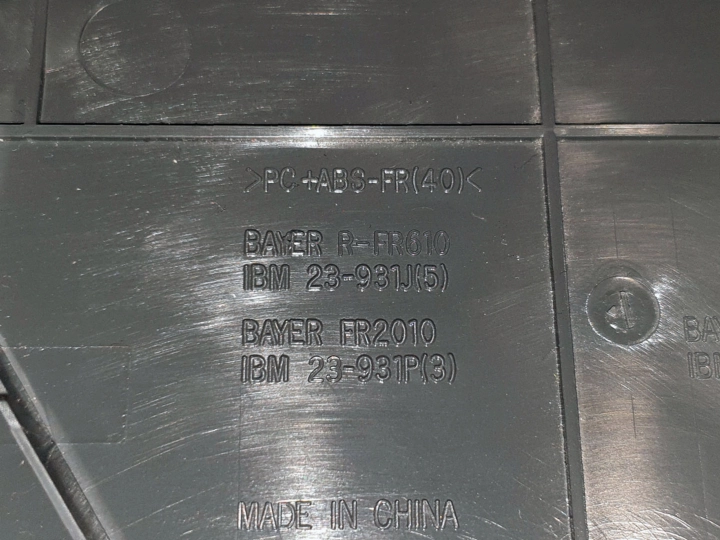
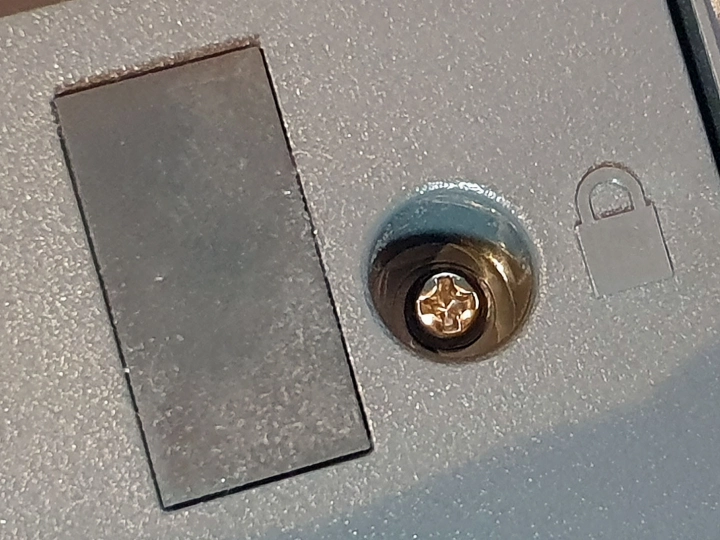
MPOS keyboards feature PC+ABS-FR(40) plastic cover sets in a very similar style to its RPOS series predecessors. PC+ABS-FR(40) is a high flow flame retardant version of PC+ABS[8]. The plastic is sturdy and taut, giving little flex and the feeling of robustness. It's also textured, but only slightly and nowhere near the level of most buckling spring keyboard cover sets. That said, the cover sets are at least somewhat wedge-shaped like its 1980s Model M ancestors but are more angular once again just like its RPOS series predecessors. All MPOS keyboards are styled similarly to maintain a uniform resemblance.
The MPOS series keyboard assembly is tightly integrated in two ways with the keyboard's cover set, more so than almost all other Model Ms except Models M1 and M2. By comparison, RPOS and pre-MPOS keyboards were just integrated in one way with their cover sets. Still, four distinct layers can be identified; the keyboard frame, the membrane blanket, the membrane assembly, and the middle frame.
- The keyboard frame (aka, the "barrel plate") sits top facing and is used to guide individual keyswitch components (the buckling sleeve rubber elements and keystems) to their correct position above the membrane assembly's contact points. Whilst buckling-spring Model Ms use a complete sub-assembly that is separable from its cover set, the MPOS-style keyboard frame is a part of the top cover piece (one of the two aforementioned integrations). The 67-key keyboards do not have any layout variation, but on MANPOS and MCANPOS, the frame design has a degree of redundancy in the number of barrels available, allowing for a 'one size fit all' design for US English ("ANSISO" - ANSI-style left shift, ISO-style enter key) and rest of world (ISO) style layouts.
- The membrane blanket is a rubber sheet used to dampen the stress the actuators exert on the membrane assembly. Without it, the longevity of the membrane assembly would be reduced[9].
- The membrane assembly is a part of the keyswitch system used as the circuitry to be actuated and facilitates a keymatrix. The size of the matrix depends on the exact keyboard in question.
- The middle frame is technically a part of the cover set (the second of the two aforementioned integrations) that the keyboard frame mounts on to with the membrane blanket and assembly inside. Most Model Ms including RPOS and pre-MPOS keyboards have a metal base plate (aka, the "back plate") instead, providing some rigidity for the assembly, but this middle frame takes its duty.
MPOS series keyboard assemblies are held together with screws, meaning the main weakness of most buckling-spring Model Ms - the plastic rivets - are not a concern for these keyboards.
The hallmark and namesake of these updated POS keyboard designs are of course their modular components. This takes the main non-button related features of the keyboards and makes them discreet devices that can be added or removed as desired. This design philosophy was presumably implemented to make repairing the keyboards easier, make customer ordering and configuration easier, and limit the amount of wholly distinct keyboard variants IBM and later Toshiba had to manufacture - for example, IBM used to market two distinct versions of the 50-key RPOS Keyboard with (Model M7) or without (M7-1) a magnetic stripe reader. The MPOS keyboards have two (67-Key) or three (MANPOS and MCANPOS) module hardpoints that can attach a specific kind of module of which 4 types are available. Each module is further explained in the Modules section.
| Hardpoint | Connector | Module | Keyboard |
|---|---|---|---|
| MSR | 6x2 | MSR | All |
| Security | 5x2 | Keylock, fingerprint | All |
| Pointing | 3x2 | Pointing | Excludes 67-Key |
The keyboards can come with no modules installed or some modules installed configured in predefined packages. If a module isn't present at purchase, a hollow blanking module will be installed (these can be ordered separately as well). All modules slide in or out of place and are secured by a single screw on the bottom of the keyboard. When removing a module, there is a press-down button with a blue-coloured sticker across it for releasing the module.
Keycaps
MPOS shares the same type of keycaps as that of late RPOS series keyboards made by XAC and XSZ, and there are likewise three types of keycaps; alphanumeric keycap, relegendable keystem, and relegendable keytop.
Alphanumeric keycaps & relegendable keystems
Alphanumeric keycaps are single-piece keycaps (keystem and keytop are integrated into each other) and use lasered (for pearl white host keyboards) or silk-screened (for grey host keyboards) legends. The alphanumeric keycaps for MANPOS are standard unit sizes, however, MCANPOS has slightly compacted keycaps. The 1-unit relegendable keystem unit size is standardised across all MPOS keyboards, however, the 67-key keyboards additionally have 1.25-unit relegendable keys. Both alphanumeric keycaps and relegendable keystems are difficult to remove without damaging the stem itself, and in some cases of misuse, the tops can break from the stems. It's possible to detach a 1-unit relegendable keystem by following these instructions:
- Remove all adjacent keytops around the given keystem you want to remove.
- Push the keystem down and turn it 90 degrees (should work regardless of clockwise or anticlockwise).
- Pull the keystem out with a wire keycap puller.
Other keys such as alphanumeric, modifiers and the spacebar can only be safely removed by opening up the keyboard assembly and pushing them out from the other side of the keyboard frame. To put a keycap back in, you simply push it back in with the two protrusions on the keystem's plug facing left and right relative to the keyboard. If the key doesn't press properly or stays stuck at the bottom, you should be able to rotate the keystem until it starts pressing normally again.
Relegendable keytops
The transparent keytops used for relegendable keycaps can be referred to as "lenses" and exist in 1x1/single and 1x2/double forms. The following variants are known, each with available with a "tall" variant as well:
- 1x1: Keytop for 1-unit keystem
- 1x2: Keytop for two 1-unit keystems (vertical or horizontal)
- Single: Keytop for a 1.25-unit keystem
- Double: Keytop for two 1.25-unit keystems (vertical only)
Using a 1x2/double keytop require configuration through the IBM/Toshiba Modular Device Utility or using the UPOS API to disable one of the two keystems from registering its own keypress, at which point, the disabled keystem acts as a stabiliser.
IBM and TGCS made kits available to add or replace keytops with, called lens kits and cap sets. A lens kit contains a variety of various keytops for a given MPOS variant, whereas a cap set contains just of one type of relegendable keytop. They may be found on Amazon, eBay, or IT reselling websites.
| Feature code | FRU | SMU | MFI | Description |
|---|---|---|---|---|
| 1420 | 46T6703 | 46Y2370 | 45X0516 | Model M-e 67-key MPOS lens kit |
| 1421 | 46T6701 | 46Y2341 | 45X0512 | Model M-e MANPOS lens kit |
| 1422 | 46T6702 | 46Y2342 | 45X0514 | Model M-e MCANPOS lens kit |
| 1426 | 46T6704 | 46Y2344 | 46V4110 | Model M-e all MPOS cap set - 1x1 (pack of 25) |
| 1427 | 46T6705 | 46Y2345 | 46V4111 | Model M-e all MPOS cap set - 1x2 (pack of 25) |
| 1428 | 46T6706 | 46Y2346 | 46V4112 | Model M-e all MPOS cap set - 1x1 tall (pack of 25) |
| 1429 | 46T6707 | 46Y2347 | 46V4113 | Model M-e all MPOS cap set - 1x2 tall (pack of 25) |
| 1430 | 46T6708 | 46Y2348 | 46V4114 | Model M-e 67-key MPOS cap set - single (pack of 25) |
| 1431 | 46T6709 | 46Y2349 | 46V4115 | Model M-e 67-key MPOS cap set - double (pack of 25) |
| 1432 | 46T6710 | 46Y2350 | 46V4116 | Model M-e 67-key MPOS cap set - single tall (pack of 25) |
| 1433 | 46T6711 | 46Y2371 | 46V4117 | Model M-e 67-key MPOS cap set - double tall (pack of 25) |
Note
Relegendable keytop kits for RPOS series keyboards should be compatible with MPOS series keyboards. Please keep in mind that RPOS series keyboards were more often pearl white than grey, and their keytops may have pearl white outlines that may not match a typical MPOS series keyboard that is more often grey than pearl white.
The MPOS keyboards exclusively use locking 6x2 IDC connector based cables, displacing the Retail and older M-e options of 8-pin AMP SDL for RS485 and PS/2 or 4x1 connector for USB. Most non-LCD 67-Key MPOS, MANPOS and MCANPOS keyboards from before 2018 support 12V powered USB, USB and PS/2, just requiring a separate cable for a particular one. However, when Toshiba introduced 3AA0xxxxxxx part number nomenclature versions of the MANPOS and MCANPOS by 2018, they dropped PS/2 support. The 67-Key MPOS LCD Keyboard always only supported 12V powered USB and USB.
| Type | 0.7m pebble gray FRU & SMU | 1.4m black FRU & SMU | 3.8m black FRU & SMU |
|---|---|---|---|
| 12V powered USB | 45U0031 | 45U0036 | 45U0038 |
| USB | 45U0011 | 45U0016 | 45U0018 |
| PS/2 | 45U0021 | 45U0026 | 45U0028 |
The simplicity of the connector's design can allow anyone to create their own replacement cables easily, even with just basic tools and equipment such as jumper wires and a sacrificial USB cable. modelrail.otenko has detailed the connection of a MANPOS keyboard and has even created a 3D printable plug casing[13].
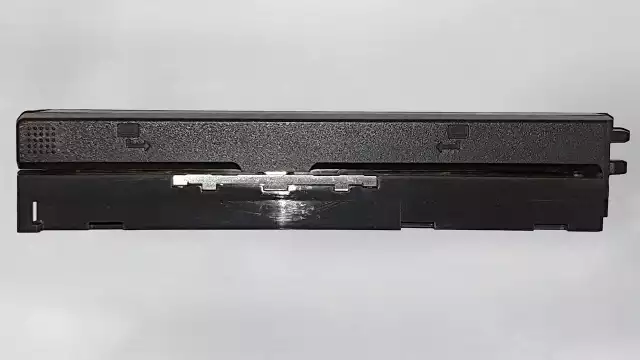
The magnetic stripe reader (MSR) module is used to read the data stored on the black stripe that swipe cards have. This modular replaces the built-in MSR most RPOS series keyboards had. Available options as of May 2014[11]:
| Type | Feature code | Colour | SMU | FRU |
|---|---|---|---|---|
| Three-track | 2260 | Grey | 44T4080 | 44T4090 |
| Three-track | 2260 | White | 44T4180 | 44T4190 |
| JUCC | 2262 | Grey | 44T4082 | 44T4092 |
| JUCC | 2262 | White | 44T4182 | 44T4192 |
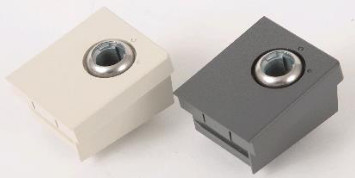
Available options as of May 2014[11]:
| Feature code | Colour | SMU | FRU |
|---|---|---|---|
| 2264 | Grey | 44T4084 | 44T4094 |
| 2264 | White | 44T4184 | 44T4194 |
Also referred to as simply as the pointing module or Glide Pad and pointer module by IBM[14], this module attaches a two-button pointing stick and a touchpad to the keyboard. TGCS era modules as said to have a Varatouch pointing stick[3] via the pointing module hardpoint. Due to their lack of said hardpoint, the 67-Key POS Keyboards cannot use this module. This module replaces the singular two-button pointing stick previous IBM and Toshiba POS keyboards could have. This module also features a large rubber half-sphere on its bottom to help support the module. Available options as of May 2014[11]:
| Feature code | Colour | SMU | FRU |
|---|---|---|---|
| 2266 | Grey | 44T4104 | 44T4096 |
| 2266 | White | 44T4105 | 44T4196 |
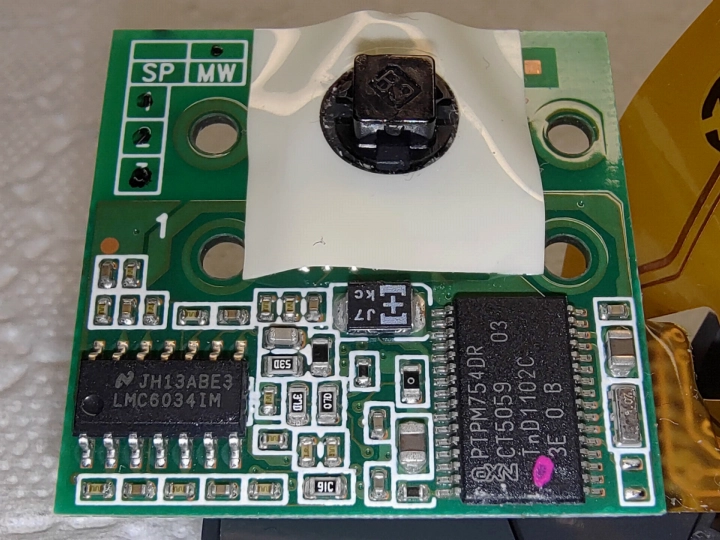
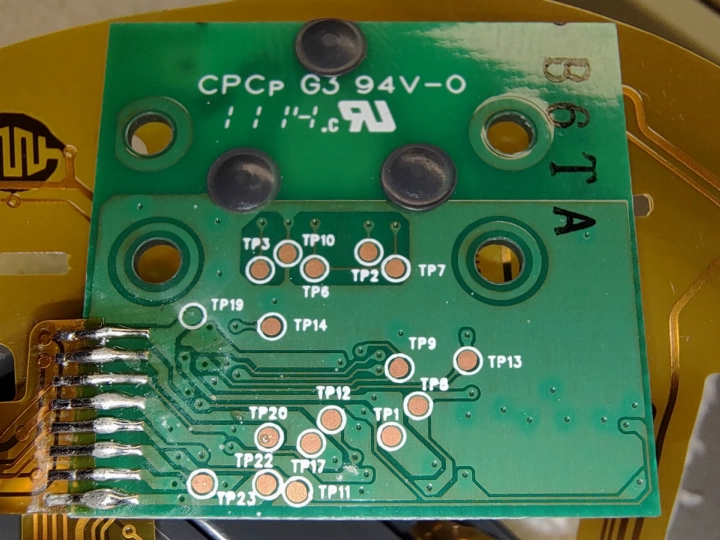
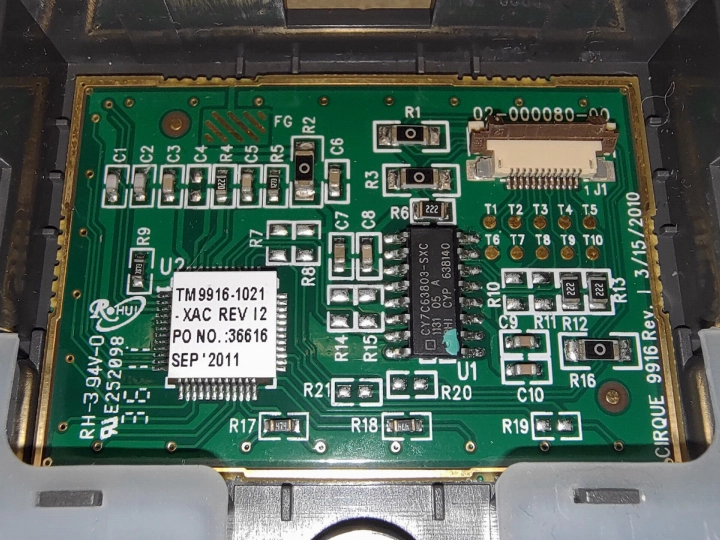
For at least IBM-era modules, the pointing stick technology used is IBM's strain gauge TrackPoint IV. The module appears to be very similar to those used in Lenovo ThinkPad T400-era laptops[15]. The touchpad used is a Cirque GlidePad as the "Glide Pad and pointer" name for this module suggests.
Note
It is not recommended to attempt opening this module. The flex cable for the mouse buttons and module connector is very fragile and can tear easily.
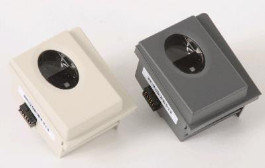
Note that the fingerprint module requires the USB cable option for it to operate. Available options as of May 2014[11]:
| Feature code | Colour | SMU | FRU |
|---|---|---|---|
| 2268 | Grey | 44T4102 | 44T4099 |
| 2268 | White | 44T4103 | 44T4199 |
The Modular 67-Key POS Keyboard is the direct successor to the IBM/Toshiba Model M7 50-key RPOS Keyboard and is thus occasionally referred to as the M7-e in fan circles. It was announced on 17th June 2008 for the IBM SurePOS 300[1]. As the name implies, the M7-e adds 17 keys over its predecessor, however, these new keys are arranged around the same basic layout as the original 50-key M7 to allow for some familiarity for IBM's customers upon upgrading and preserve application-level compatibility. Also included from the M7 design is a dedicated Ctrl key that cannot be reprogrammed and the same numeric keypad with a double-width 0 key by default, giving the design 65 total programmable keys out of the box (66 if the "0" keycap is removed). Being an MPOS series device, the MSR and key lock are now modular attachments instead of fixed components. As such, the M7-1 (M7 without built-in MSR) is also succeeded by the M7-e.
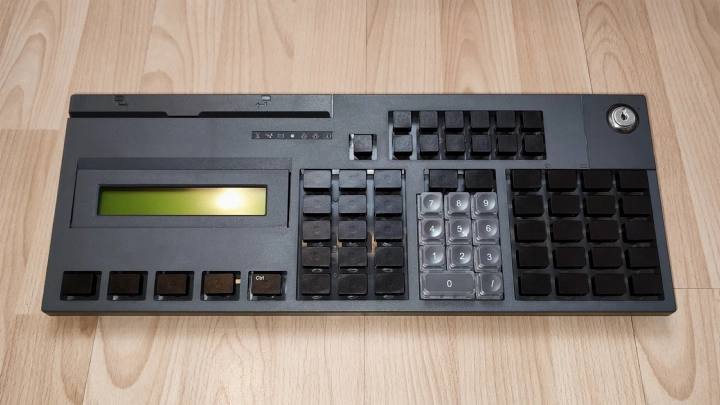
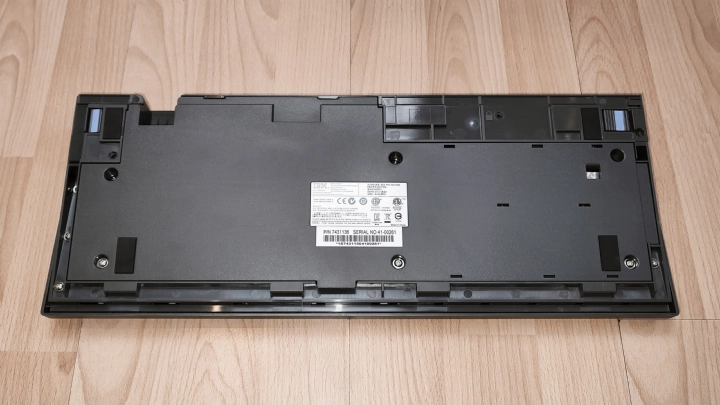
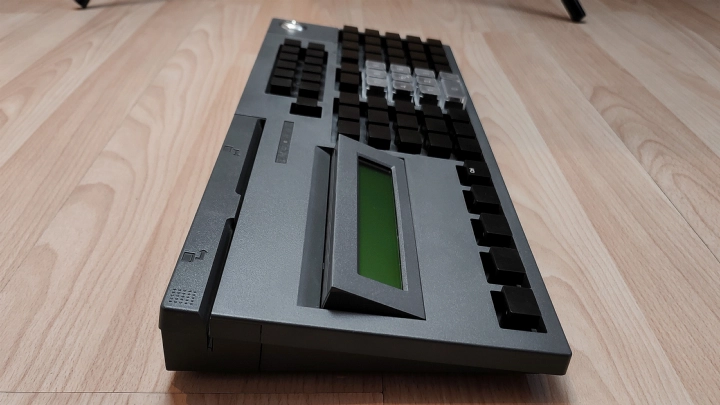
The Modular 67-Key POS LCD Keyboard is the direct successor to the IBM/Toshiba Model M8 50-key RPOS LCD Keyboard and is thus occasionally referred to as the M8-e in fan circles. Its planned availability was 14th October 2011 for the IBM SurePOS 300[4]. The changes and narrative echo that of the non-LCD version. As the name implies, the M8-e adds 17 keys over its predecessor, however, these new keys are arranged around the same basic layout as the original 50-key M8 to allow for some familiarity for IBM's customers upon upgrading and preserve application-level compatibility. Also included from the M8 design is a dedicated Ctrl key that cannot be reprogrammed and the same numeric keypad with a double-width 0 key by default, giving the design 65 total programmable keys out of the box (66 if the "0" keycap is removed). Being an MPOS series device, the MSR and key lock are now modular attachments instead of fixed components.
The Modular Alphanumeric POS Keyboard (MANPOS) is the direct successor to the original Model M-e based IBM PS/2 ANPOS Keyboard with Integrated Pointing Device (hence IBM originally called this design the IBM Modular PS/2 ANPOS II Keyboard[14]). It was announced on 17th June 2008 for the IBM SurePOS 300[1]. The M-e PS/2 ANPOS itself was a Model M-e upgrade of the original Model M9 RANPOS Keyboard. Being an MPOS series device, the MSR and key lock are now attachments instead of fixed components and the design now gains a touchpad compared to a PS/2 ANPOS Keyboard or any pointing device compared to the M9. In terms of layout modification, the changes are tame - only 3 programmable keys have moved to make way for the pointing module. The status indicators panel is also much smaller now.
The Modular Compact Alphanumeric POS Keyboard (MCANPOS) is the direct successor to the original IBM CANPOS Keyboard (hence why IBM-branded MCANPOS were also known as IBM Modular CANPOS II Keyboards). It was announced on 17th June 2008 for the IBM SurePOS 300[1]. The original CANPOS itself was a compact redesign of the Model M9 RANPOS Keyboard. Both CANPOS and MCANPOS fit a full-size keyboard and many programmable keys in a chassis that is a similar width to a tenkeyless keyboard. Additionally, all alphanumeric keys are slightly thinner compared to their M9 ANPOS, M-e PS/2 ANPOS and MANPOS counterparts. Once again as you may expect, MCANPOS made many of CANPOS's features modular but in this case, it also added the possibility of a key lock and a touchpad that the original CANPOS could never have. No extra keys were added despite some programmable key layout alterations, meaning both CANPOS and MCANPOS have 133 (US English) or 134 (rest of world) keys. Extra status indicators were also added; CANPOS only had three keyboard lock-lights, MCANPOS adds a "Wait", "Offline", "Message Pending" and a user-definable light.
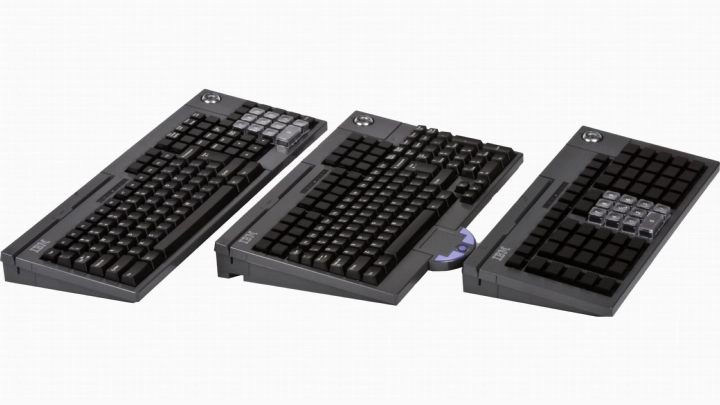
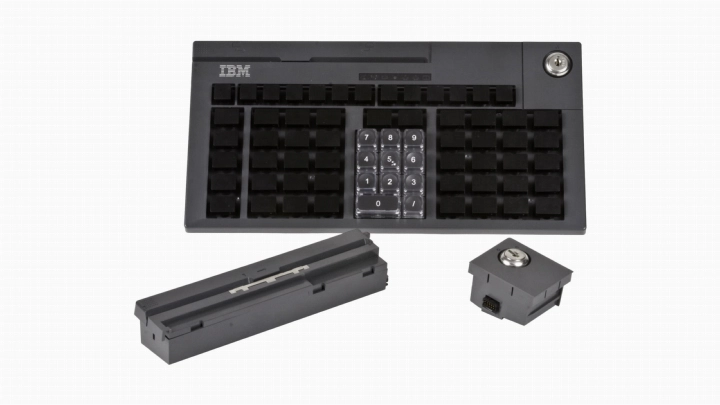
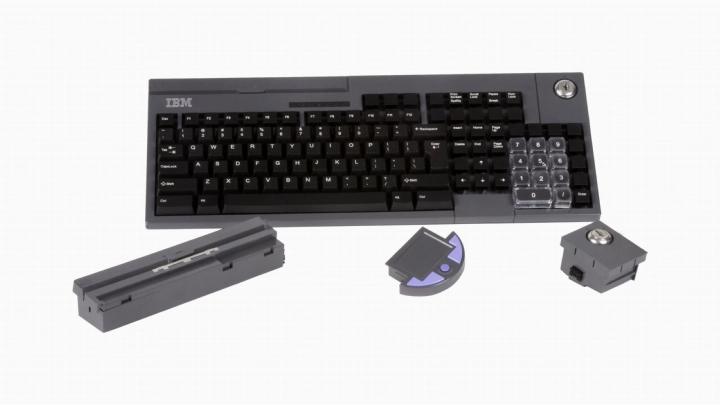
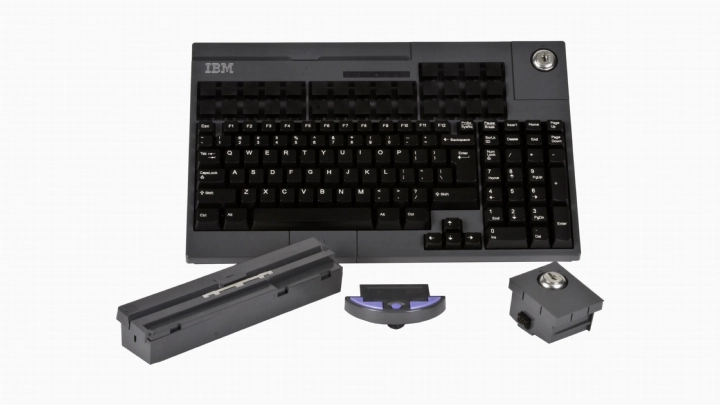
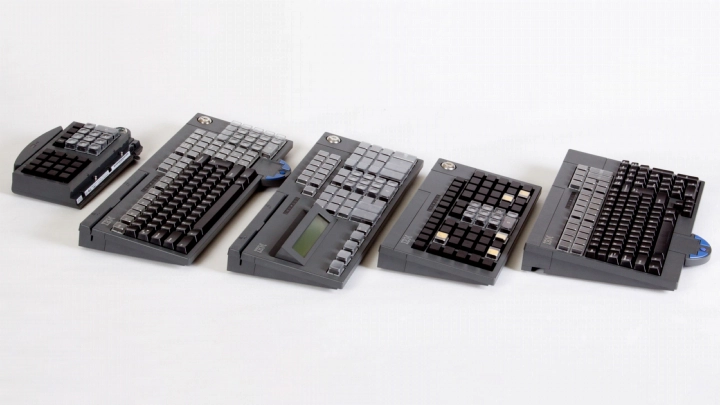
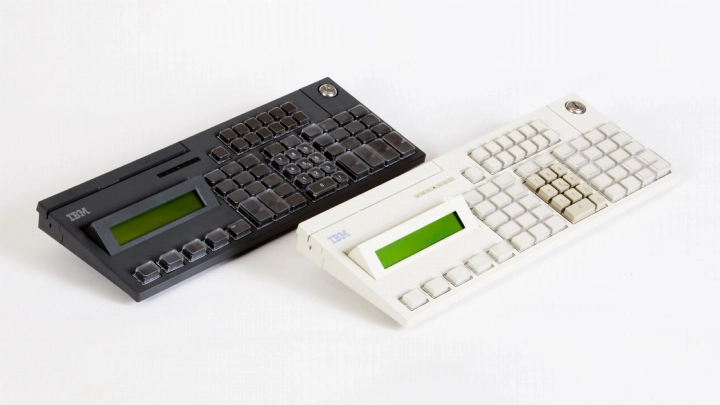
Part number list
57 keyboard part numbers have been found in the ASK Keyboard Part Number Database. If you believe a relevant part number is missing, you can help improve this list by requesting a submission for it to be added.
- P/N 00DN121 (FRU 00DN161): Toshiba Modular CANPOS Keyboard
- P/N 00DN136 (FRU 00DN174): Toshiba Modular 67-Key Keyboard with 2x20 LCD
- P/N 00DN181 (FRU 00DN210): Toshiba Modular ANPOS Keyboard
- P/N 00DN207 (FRU 00DN236): Toshiba Modular 67-Key Keyboard
- P/N 3AA01195500 (FRU 3AC00610300): Toshiba Modular ANPOS Keyboard
- P/N 3AA01198500 (FRU 3AC00610300): Toshiba Modular ANPOS Keyboard (2280)
- P/N 3AA01198600 (FRU 3AC00610400): Toshiba Modular ANPOS Keyboard (2290)
- P/N 3AA01198700 (FRU 3AC00610500): Toshiba Modular ANPOS Keyboard (2284)
- P/N 3AA01198800 (FRU 3AC00610600): Toshiba Modular ANPOS Keyboard (2286)
- P/N 3AA01198900 (FRU 3AC00610700): Toshiba Modular ANPOS Keyboard (2288)
- P/N 3AA01199000 (FRU 3AC00610800): Toshiba Modular ANPOS Keyboard (2282)
- P/N 3AA01199100 (FRU 3AC00610900): Toshiba Modular ANPOS Keyboard (2292)
- P/N 3AA01200500 (FRU 3AC00611700): Toshiba Modular CANPOS Keyboard (2250)
- P/N 3AA01200600 (FRU 3AC00611800): Toshiba Modular CANPOS Keyboard (2254)
- P/N 3AA01200700 (FRU 3AC00611900): Toshiba Modular CANPOS Keyboard (2251)
- P/N 3AA01200800 (FRU 3AC00612000): Toshiba Modular CANPOS Keyboard (2252)
- P/N 3AA01200900 (FRU 3AC00612100): Toshiba Modular CANPOS Keyboard (2256)
- P/N 3AA01201000 (FRU 3AC00612200): Toshiba Modular CANPOS Keyboard (2253)
- P/N 3AA01201100 (FRU 3AC00612300): Toshiba Modular CANPOS Keyboard (2255)
- P/N 3AA01201200 (FRU 3AC00612400): Toshiba Modular CANPOS Keyboard (2257)
- P/N 3AA01201700: Toshiba Modular CANPOS Keyboard w/ Touchpad & Point Stick
- P/N 3AA01201800 (FRU 3AC00612800): Toshiba Modular 67 Key Keyboard (2270)
- P/N 3AA01202800 (FRU 3AC00613000): Toshiba Modular 67 Key Keyboard w/ LCD (2240)
- P/N 3AA01203000: Toshiba Modular 67 Key Keyboard w/ LCD & MSR/Keylock
- P/N 3AA02285300 (FRU 3AC00985700): Toshiba Modular ANPOS Keyboard (2281)
- P/N 3AA02285400 (FRU 3AC00985800): Toshiba Modular ANPOS Keyboard (2283)
- P/N 3AA02285500 (FRU 3AC00985900): Toshiba Modular ANPOS Keyboard
- P/N 3AA02285600: Toshiba Modular ANPOS Keyboard
- P/N 3AA02285700: Toshiba Modular ANPOS Keyboard
- P/N 3AA02285800: Toshiba Modular ANPOS Keyboard w/ Keylock
- P/N 3AA02285900: Toshiba Modular ANPOS Keyboard w/ Keylock
- P/N 3AA02286000 (FRU 3AC00986000): Toshiba Modular CANPOS Keyboard (2150)
- P/N 3AA02286100 (FRU 3AC00986100): Toshiba Modular CANPOS Keyboard (2151)
- P/N 3AA02286200 (FRU 3AC00986200): Toshiba Modular CANPOS Keyboard (2152)
- P/N 3AA02286300: Toshiba Modular CANPOS Keyboard w/ Touchpad & Point Stick
- P/N 3AA02286400 (FRU 3AC00986300): Toshiba Modular 67 Key Keyboard (2271)
- P/N 3AA02286500: Toshiba Modular 67 Key Keyboard w/ Keylock
- P/N 3AA02286600: Toshiba Modular 67 Key Keyboard w/ Keylock
- P/N 3AA02286700 (FRU 3AC00986400): Toshiba Modular 67 Key Keyboard w/ LCD (2241)
- P/N 3AA02286800: Toshiba Modular 67 Key Keyboard w/ LCD & MSR/Keylock
- P/N 3AA02290300 (FRU 3AC00986500): Toshiba Modular ANPOS Keyboard (2287)
- P/N 3AA02290400 (FRU 3AC00986600): Toshiba Modular ANPOS Keyboard (2289)
- P/N 3AA02290500 (FRU 3AC00986700): Toshiba Modular ANPOS Keyboard (2293)
- P/N 3AA02290600 (FRU 3AC00986800): Toshiba Modular ANPOS Keyboard (2295)
- P/N 3AA02290700 (FRU 3AC00986900): Toshiba Modular CANPOS Keyboard (2153)
- P/N 3AA02290800 (FRU 3AC00987000): Toshiba Modular CANPOS Keyboard (2154)
- P/N 3AA02290900 (FRU 3AC00987100): Toshiba Modular CANPOS Keyboard (2155)
- P/N 3AA02291000 (FRU 3AC00987200): Toshiba Modular CANPOS Keyboard (2156)
- P/N 65Y4044 (FRU 65Y4094): IBM Modular 67-Key Keyboard with LCD Display
- P/N 65Y4045 (FRU 65Y4091): IBM Modular 67-Key Keyboard
- P/N 65Y4047 (FRU 65Y4095): IBM Modular 67-Key Keyboard
- P/N 7431184 (FRU 50Y7034): IBM Modular 67-Key Keyboard with LCD Display
- P/N 93Y1131 (FRU 65Y4071): IBM Modular CANPOS II Keyboard
- P/N 93Y1223 (FRU 93Y1203): IBM Modular ANPOS II Keyboard
- P/N 93Y1231 (FRU 65Y4641): IBM Modular CANPOS II Keyboard (1350)
- P/N 93Y1232 (FRU 65Y4642): IBM Modular CANPOS II Keyboard (1350)
- P/N 93Y1233 (FRU 65Y4643): IBM Modular CANPOS II Keyboard
Internal
External
Documents
Downloads
Disclaimer
All the downloads are believed to be safe and free to rehost, and I do not claim ownership of any of these files nor do I provide warranty for them or liable if you misuse them in any way. Use at your own risk.
- IBM/Toshiba Modular Device Utility v1.0.36: direct IBM link (~72.9MB compressed ZIP) - ASK backup (~60.4MB compressed 7-zip)
- IBM - IBM SurePOS 300 machine type 4810 offer new point-of-sale keyboards [accessed 2022-06-19].
- IBM - Toshiba TEC to Acquire IBM’s Retail Store Point-of-Sale Solutions Business; Agreement Allows Both to Tap Growing Smarter Commerce Opportunity [accessed 2021-06-17].
- Toshiba - Toshiba POS Keyboards Technical Specifications [accessed 2022-04-06].
- IBM - IBM SurePOS 300: New IBM Modular 67-Key POS Keyboard with LCD Display offers increased security and additional customization options [accessed 2022-04-06].
- IBM - IBM 4694 POS Terminal Model 001 Brief Description of Announcement, Charges, and Availability (#193-150) [accessed 2022-04-23].
- IBM - IBM Point of Sale Subsystem Installation, Keyboards, and Code Pages [accessed 2022-04-08].
- IBM - IBM SurePOS 500 Series Overview [accessed 2022-04-08].
- idemitsu - Flame retardant PC alloy grade Properties [accessed 2022-04-10].
- troyfletcher#5223 - Discord Message #252446027745853442 on IBM keyboards | /r/ModelM & F [accessed 2023-02-21].
- Toshiba - Toshiba Guide to Features - SurePOS 700 Models 4900-xx5 (#1R1003844-xx5) [accessed 2024-11-25]. License/note: photos used under fair dealing.
- Toshiba - Toshiba Guide to Features - SurePOS 700 Models 4900-xx5 (#1R1003844-xx5) [accessed 2023-06-13]. License/note: photos used under fair dealing.
- TheMK#1822 - contributed PS/2 pinout information.
- modelrail.otenko - IBM 45U0018 POS Keyboard [accessed 2022-04-09].
- IBM - IBM Point of Sale Options and I/O Devices Service Guide DRAFT [accessed 2022-04-06].
- Deskthority Wiki - TrackPoint Hardware#ThinkPad T400 TrackPoint [accessed 2023-04-18].
- IBM - ftp://public.dhe.ibm.com [accessed 2022-06-29]. License/note: archived from IBM public FTP & used under fair dealing.
| Published | Comment |
|---|---|
| 25th November 2024 | Rewrote Keyswitches & Internal assembly sections, added list of keycap kits & replaced various used enthusiast terminology with official terminology |
| 1st February 2024 | Added part number list section & added link to download IBM Modular Device Utility |
| 11th May 2023 | Add photos of white pointing module |
| 18th April 2023 | Added photos and brief description of the Touch Pad/Pointer module's internals |
| 5th January 2023 | Correct duplicate gallery photo |
